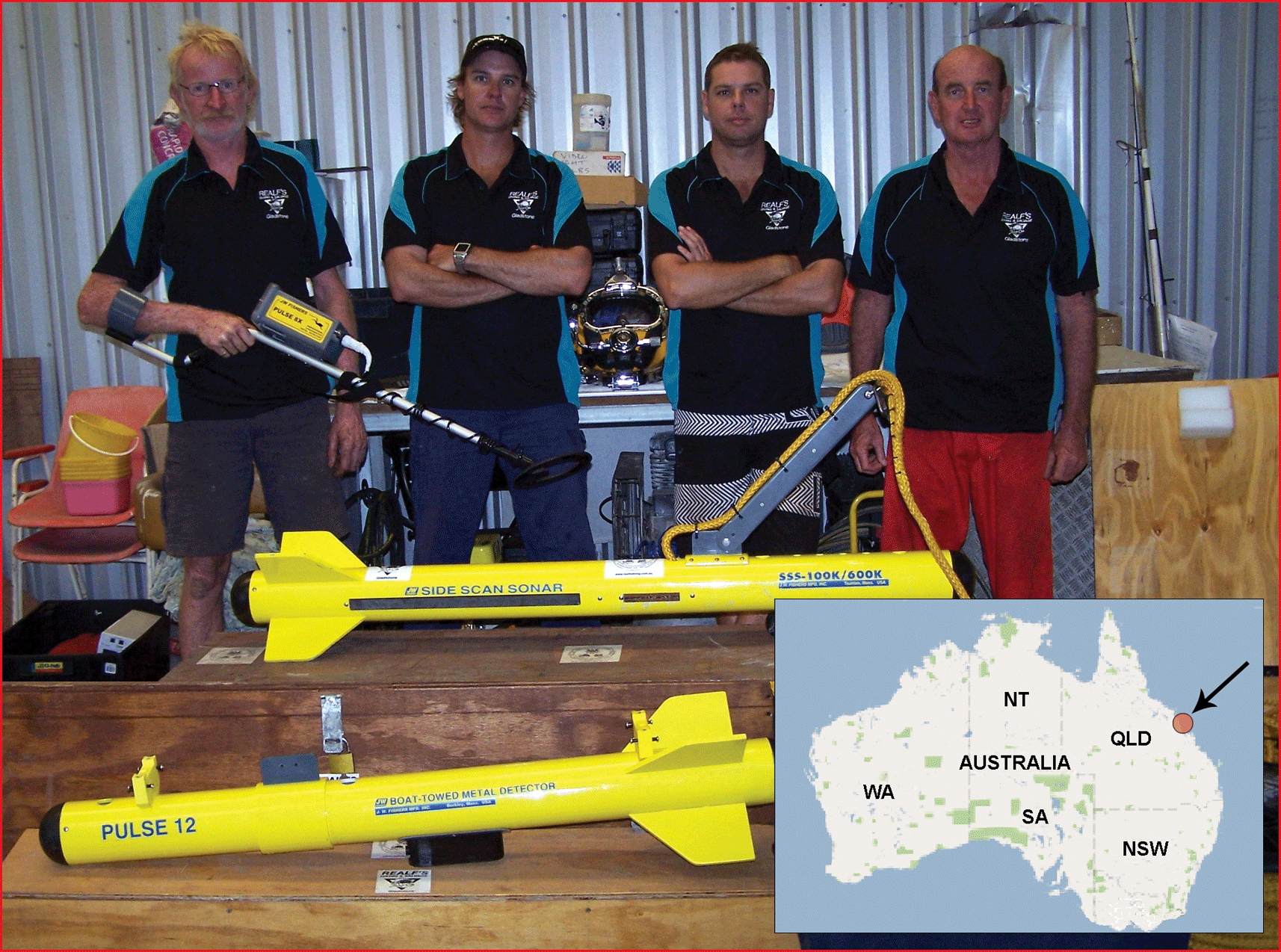
The team from Realf's Diving and Salvage in Queensland, Australia with their Fisher Pulse 8X metal detector, SSS-100K/600K side scan sonar, and Pulse 12 towed metal detector. Dive supervisor John Realf on left with Pulse 8X.
The Central Queensland Port Authority is undertaking one of the largest capital improvement projects in Australia. The RG Tanna Wharf Expansion Project involves extending the pier by 350 meters, widening existing berths, building a 1.3 kilometer onshore conveyor, and creating a new jetty approach. The cost of the construction portion alone is $128 million. Marine contractor Realf's Diving and Salvage was hired to survey the area before the dredging operation could begin. The company is based in Gladstone, Queensland and has performed jobs for a number of high profile customers including Bechel Corporation, Australia's Department of Fisheries, Dept.of Natural Resources, Customs Service, and the Brisbane Port Authority. Realf's provides a variety of services for their clients including underwater cutting and welding, ship maintenance and repair, in-water surveys, salvage, and insurance work. Using JW Fishers side scan sonar and metal detectors Realf's team of divers and marine specialists located and removed a considerable quantity of underwater debris in the wharf area including some large metal objects that could have done considerable damage to the dredges.
Dive Supervisor John Realf filed the following report on the survey and salvage operations. "On arrival at the site we met with the Surveyor to define the search area. Shot lines fitted with buoys were dropped to define the perimeter. This area was then systematically searched using the SSS-100K/600K side scan sonar. All sonar data was captured and stored on the computer with position coordinates and the operator's notations for later reference. Numerous targets were found on the seabed within the search grid which had to be removed by the 250 ton crane on support barge Yarra 1. Targets located and removed included concrete blocks, wire cables, a 17 ton anchor, car tires, and timber logs. The seabed was soft mud, and we were concerned that other objects could be hidden beneath the bottom. The same area was searched again using our Pulse 12 boat-towed metal detector. While running the grid, a number of targets were detected and their positions marked. After completing the search, a diver with the hand-held Pulse 8X metal detector was deployed at the locations where the Pulse 12 registered anomalies. He found a range of buried objects which included more steel rope, pieces of pipe and even small beverage containers. On a few of the marked sites the Pulse 8X gave no significant reading, indicating the target was a considerable depth under the seabed and would not interfere with the dredging operation."
Another group using Fishers equipment in their operations is the Royal Australian Navy Hydrographic Service (AHS). This agency is charged with the responsibility of mapping and surveying undersea terrain to enable safe navigation. Under international agreements the Australian charting area spans approximately one-eighth of the world's surface, extending from Cocos Island to the west, Solomon Islands to the east, the Equator to the north, and Antarctica to the south. One of the tools AHS is employing in their operations is Fishers Proton 4 magnetometer. A super sensitive detector of iron and steel targets, the magnetometer can locate a variety of underwater objects from shipwrecks to lost anchors. A special software package allows the Proton 4 readout data and position coordinates to be displayed and stored on a computer. Also shown on the screen is the track of the vessel as it runs a grid over the search area, ensuring no section is missed. In addition to the magnetometers, AHS is also using Fishers MC-1 mini camera. The mini camera is a versatile underwater video system that can be mounted on a commercial diver's helmet, attached to a pole and lowered into the water to survey an underwater structure, used as a drop camera to verify targets located by the magnetometer, or carried by a diver to videotape an inspection. The picture can be viewed on a monitor, a TV, or a computer, and recorded onto DVD.
For more information on Realf's Diving and Salvage go to www.realfsdiving.com.au.
